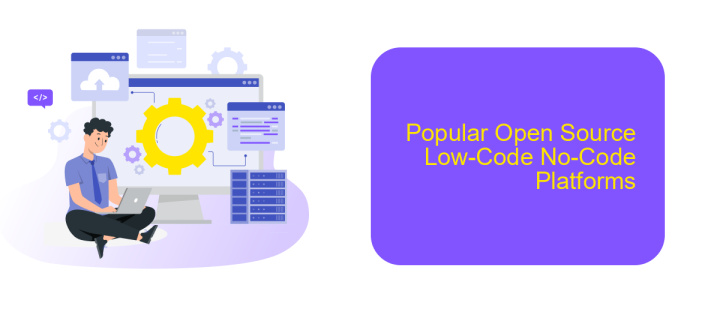Open Source Low-Code No-Code Platforms
Open Source Low-Code No-Code Platforms are revolutionizing the way businesses and developers approach software development. By offering user-friendly interfaces and pre-built components, these platforms empower users with little to no coding experience to create robust applications quickly and efficiently. This democratization of software development is accelerating innovation and reducing costs, making technology more accessible to everyone.
Introduction: Defining Low-Code No-Code Platforms
Low-code and no-code platforms have revolutionized the way businesses approach software development. These platforms enable users to create applications with minimal or no coding experience, democratizing the development process and accelerating digital transformation.
- Low-Code Platforms: These platforms provide a visual development environment with pre-built templates and drag-and-drop components, requiring some coding knowledge for customization.
- No-Code Platforms: These platforms allow users to build applications entirely through graphical user interfaces, eliminating the need for any coding skills.
By leveraging low-code and no-code platforms, organizations can swiftly develop and deploy applications, reducing time-to-market and operational costs. Additionally, services like ApiX-Drive facilitate seamless integration with various tools and systems, further enhancing the capabilities of these platforms. This approach empowers non-technical users to contribute to the development process, fostering innovation and efficiency within the organization.
Benefits and Use Cases for Open Source Low-Code No-Code Platforms

Open source low-code no-code platforms offer numerous benefits, including accelerated development cycles, cost efficiency, and enhanced accessibility for non-technical users. These platforms democratize software development by enabling individuals with minimal programming skills to create functional applications. As a result, businesses can reduce their reliance on traditional development teams and save on associated costs. Moreover, the open-source nature allows for extensive customization and community-driven improvements, ensuring that the platforms remain up-to-date with the latest technological advancements.
One of the primary use cases for these platforms is rapid prototyping, where businesses can quickly develop and iterate on new ideas without significant investment. Additionally, they are ideal for automating routine tasks and integrating various systems. For instance, services like ApiX-Drive facilitate seamless integration between different applications, enabling users to automate workflows without writing a single line of code. This capability is particularly valuable for small and medium-sized enterprises looking to streamline operations and improve efficiency without extensive technical resources.
Technical Considerations and Challenges

When considering Open Source Low-Code No-Code Platforms, several technical factors and challenges must be addressed to ensure successful implementation and operation. These platforms offer flexibility and ease of use, but they also come with specific technical requirements and potential obstacles.
- Scalability: Ensuring the platform can handle increasing workloads and user demands is crucial.
- Security: Implementing robust security measures to protect data and prevent unauthorized access.
- Integration: Seamlessly integrating with existing systems and third-party applications, such as using ApiX-Drive for efficient API management.
- Customization: Balancing the ease of use with the need for custom features and functionalities.
- Documentation and Support: Availability of comprehensive documentation and active community support.
Addressing these considerations can help mitigate potential challenges and enhance the effectiveness of Open Source Low-Code No-Code Platforms. Utilizing services like ApiX-Drive can simplify integration processes, ensuring that the platform works harmoniously with other tools and systems. By focusing on scalability, security, integration, customization, and support, organizations can leverage these platforms to drive innovation and efficiency.
Popular Open Source Low-Code No-Code Platforms

Open source low-code and no-code platforms have gained significant popularity due to their flexibility and cost-effectiveness. These platforms empower users to create applications with minimal coding knowledge, making software development more accessible.
Several open source platforms stand out in this domain, offering robust features and active community support. These platforms enable rapid application development, customization, and integration with other tools and services.
- Appsmith: A powerful tool for building internal tools and admin panels quickly.
- Budibase: An open-source platform designed for creating business applications effortlessly.
- Joget: A platform focusing on workflow management and rapid application development.
- Node-RED: A flow-based development tool for visual programming, ideal for IoT applications.
Integrating these platforms with external services can further enhance their capabilities. For instance, ApiX-Drive offers a seamless way to connect various applications and automate workflows, making it an excellent addition to any low-code or no-code toolkit. By leveraging these platforms, businesses can accelerate their digital transformation and innovate more efficiently.


Best Practices and Considerations for Implementing and Using Low-Code No-Code Platforms
When implementing and using low-code no-code platforms, it is essential to begin with a clear understanding of your project's requirements and goals. Define the scope and complexity of the applications you wish to build to ensure the chosen platform can meet your needs. Engage stakeholders early in the process to gather input and set expectations. This collaborative approach not only aligns the project with business objectives but also fosters user adoption and satisfaction.
Another best practice is to prioritize integration capabilities. Platforms like ApiX-Drive facilitate seamless integration between various applications, making it easier to automate workflows and enhance functionality. Ensure that your low-code no-code platform supports API integrations and can connect with your existing systems. Additionally, provide adequate training and resources for your team to leverage the platform effectively. Continuous monitoring and iterative improvements will help you maximize the benefits and maintain the agility of your development process.
FAQ
What is a Low-Code/No-Code platform?
How do Low-Code/No-Code platforms benefit businesses?
Can Low-Code/No-Code platforms be used for complex applications?
How can I integrate various services and automate workflows using a Low-Code/No-Code platform?
Are Low-Code/No-Code platforms secure?
Do you want to achieve your goals in business, career and life faster and better? Do it with ApiX-Drive – a tool that will remove a significant part of the routine from workflows and free up additional time to achieve your goals. Test the capabilities of Apix-Drive for free – see for yourself the effectiveness of the tool.

